#sequential title number
Photo

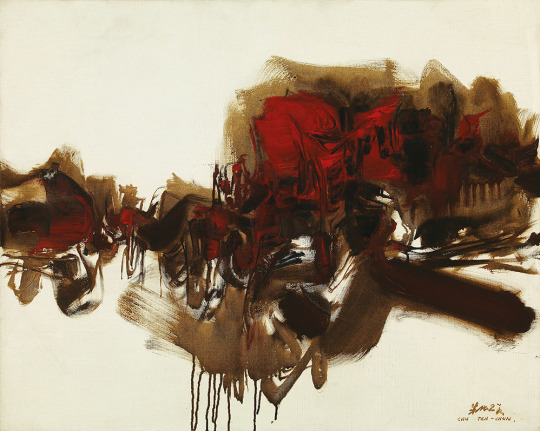

朱德群 CHU TEH-CHUN
untitled (1998) / composition no. 133 (1962) / composition no. 123
#log.#art.#abstract#on my hands and knees asking abstract painters to choose titles that aren’t just sequential numbers
16 notes
·
View notes
Text
anyway since a lot of it might be getting overwritten soon now that filoni is revisiting the inquisitorius characters (i assume he is? he wrote basically all of tales of the jedi right): here's what i understand of the inquisitor lore outside of the rebels show
Palpatine was keeping an eye out for Jedi who seemed at odds with the Order and/or susceptible to the dark side during the war (and likely earlier, much like with Anakin), either in person or using various agents (can be assumed and is shown in Rise of the Red Blade). this likely includes Jedi with specific knowledge or skills (the implication i got from Cere in Jedi: Fallen Order)
the groundwork for what would become the Inquisitorius was already in place by the time of the war's end
the Grand Inquisitor was a former Temple Guard who felt held back by the order and had a grudge against Jocasta Nu specifically (pretty sure this comes from Rebels and shows up in Darth Vader 2017). he was recruited at some point prior to Order 66 by Palpatine personally and promised leadership of the organization. this happened before Vader's conversion, and neither Vader nor the GI were informed of each other's existence at first (DV 2017).
several former Jedi were recruited willingly (eg. the GI, Iskat Akaris/13th Sister, Prosset Dibs/10th Brother, 5th Brother according to Battle Scars, Reva Sevander/Third Sister)
most (?) inquisitors were recruited by force, specifically torture upon being captured, usually during Order 66 (eg. Trilla Suduri/Second Sister (JFO), Seventh Sister (described as feeling broken in the Force in RotRB), Tualon Yaluna (RotRB), Masana Tide/Ninth Sister (JFO))
their primary purpose seems to be killing Jedi survivors rather than expanding their ranks by recruiting them. although it is a fear for those hunted by them, the inquisitors rarely try it, even if they do taunt their prey with the possibility (Masana's dialogue in JFO). this may have changed in the later years as the inquisitor numbers dwindled (i'm pretty sure they were actually trying to convert Ezra during Rebels. please correct me.)
they do, however, often try to kidnap Force-sensitive children too young to have been pre-Empire Jedi. this appears to include any age group and be the continuation of Palpatine's project during the clone wars. (i believe this is expanded upon in Rebels? it's a plot point in DV 2017 with Eeth Koth's infant daughter. also, i might have made this up but it seems to be the implied threat in Jedi: Survivor.)
the numbered titles appear to reference the order of initiation, with the GI being implicitly the First but never referred to as such. the numbers do not change over an inquisitor's tenure and do not seem to be replaced when an inquisitor falls. there do not seem to be duplicates (except for the Third Brother, who appears in a reference book written before Obi-Wan Kenobi and whose existence seems to have been overwritten by the Third Sister's. her character's age and implied backstory do not fit this naming assumption, however.)
if the naming is sequential, then siblings 2 through 10 join very shortly after Order 66, and number 13 gets initiated within months (RotRB). we still don't know 11 and 12.
there is some number of active inquisitors without a numbered title, who still go by their old names. these seem to have similar duties and authority to their numbered colleagues and are also referred to as "brother" or "sister", at least by other inquisitors. (Tualon in RotRB)
there might (?) be some hierarchy to the numbers, with lower numbers corresponding to a higher position. or not. (Third Sister seems to think she's next in line after the deaths of Grand Inquisitor and Second Sister as per Obi-Wan Kenobi. there's a confusing exchange somewhere in Rebels where Seventh and Fifth pointedly emphasize their titles to each other while having a disagreement but i have no idea what that means.)
inquisitors do occasional solo missions but mostly seem to work in pairs or small groups. the chain of command during these missions seems ambiguous, possibly intentionally so. Darth Vader joins in for some missions, where all inquisitors defer to him.
originally recruited inquisitors are not trained after joining outside of sparring with each other, which seems entirely voluntary. sometimes Darth Vader drops in and tests them, often ending in mutilation. they are allowed and perhaps even encouraged to study the dark side on their own time, though they do not have many opportunities to do so, possibly by design. (RotRB)
inquisitors are not Sith, and are not officially intended to become Sith, though as dark side adepts they are a potential source of replacement apprentices. (i believe this is fan speculation and out of universe material more than actual text but would love to be proven wrong)
Inquisitorius personnel have authority over some other Imperial forces, and have a long-term rivalry with the ISB (JS). they are generally an unknown force.
the organization was founded on Coruscant and headquartered there for about 5 years after its founding. (DV 2017) afterwards, its HQ transferred to Nur. however, that facility was already in heavy use immediately after and possibly before Order 66 (backstory in JFO).
the members get killed off pretty quickly. 6th and 10th die within a year, 2nd and 13th (along with her bf without a number) within 5 years, 3rd and 9th 5 years after that (Reva actually leaves, as we know). the ones that make it to Rebels die in that show. Fourth Sister is unaccounted for.
inquisitors tend to die by Vader or Ahsoka and Maul.
6 notes
·
View notes
Note
For the meme!!! 21 - 22 - 23
We love a sequential number sequence :D
21. Could you ever quit writing? Do you ever wish you could? Why or why not?
I mean, yeah, maybe one day! I don't want to quit writing, I certainly don't wish I could. I love this job! It's been my favourite ever job! It's also been the hardest fucking job I've ever done!!! But I still love it :'D
I don't want to say 'I'm never going to quit' - I don't know what the future might bring. The arthritis in my hands is pretty bad, maybe one day I'll be in too much agony to justify it. Maybe one day I'll just stop enjoying it. I don't believe in sticking something out forever based on how I feel about it now!
I can say with all confidence that I don't want to quit. The biggest flaw in this version of my job is that it doesn't pay super great for the amount of work that goes into it. BUT, it definitely pays better than working as a professional artist did, and there is growth, and amazing people do support the Patreon, so it's like...that flaw becomes less of a flaw over time.
I love this job. It wasn't one I would have picked for myself, but it's introduced me to the best people, it's something I feel I'm actually pretty good at (maybe I'm not, but this is a nice feeling to have), and it's kind of unique. I get to be my own boss (I'm a mean boss, but I'm getting better), and I get to work from home, and I can accommodate my chronic illnesses. I get to spend time in amazing worlds, with amazing characters, and then I get to reply to amazing comments and asks made by amazing people.
Like, when this job is going well, I feel like one of the luckiest people. When this job is hard I just groan a lot and take painkillers for editing headaches. But like, the good parts of this job are very good!!
22. How organized are you with your writing? Describe to me your organization method, if it exists. What tools do you use? Notebooks? Binders? Apps? The Cloud?
I'm pretty organised.
So, all of my chapters are written in Microsoft Word and saved directly into Dropbox (with offline storage as well). All of my folders are also very well organised. I have a naming system for each chapter, and everything is chained together pretty well.
On top of that I now use Obsidian for worldbuilding (it's free! Though you can pay and they deserve money for their awesome service). I used to use World Anvil but found it too clunky for my personal needs. I have about 4 Obsidian vaults now (i.e. different worlds) and they look like this:

You can see a chained folder system on the left, and the graph view on the right.
And the information in the individual files is set up like a Wiki page:
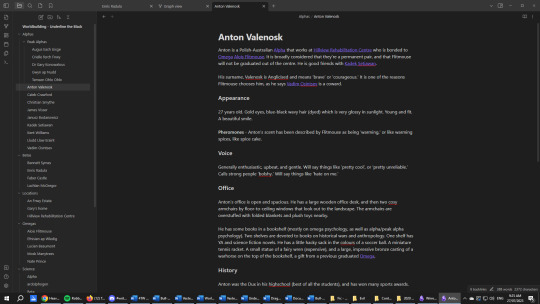
Not all of my worlds get this treatment, but Underline the Rainbow, Vexteria, Mallory & Mount and something else I've forgotten about all have vaults. Fae Tales doesn't, because I didn't know Obsidian existed when I started worldbuilding for that, lol, so all of that is in Word.
And then I will on occasion just write in notepads and in Paperblanks journals when I need to brainstorm stuff. This part of the process is especially useful when plotting, brainstorming names or titles, or figuring out the end of a story.
I don't use Google Docs (don't actually like it), Scrivener (hate it, sorry Scrivener fans), or anything else. Word has its issues, but it does well enough for me. I actually formatted Perth Shifters in Word.
23. Describe the physical environment in which you write. Be as detailed as possible. Tell me what’s around you as you work. Paint me a picture.
I write in a study dedicated to art/writing, because those have been my jobs for over 15 years. I sit at a large desk, and have a desktop computer with one monitor (I've wanted two monitors for such a long time), a decent speaker system, and a good RGB hard-drive.
It's a mess, lol.
Hang on let me show you:
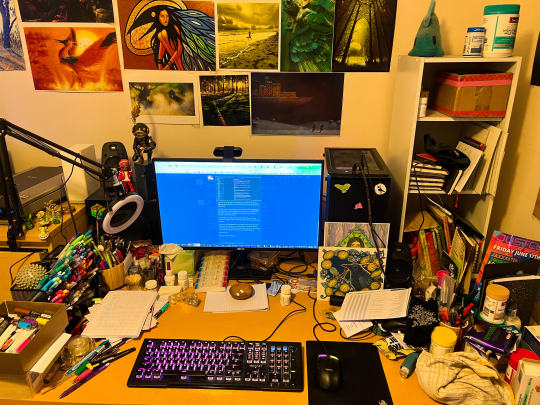
I have stickers on the desktop by the immaculate WhiskeyRabbit. I have a bunch of art supplies, and art in various stages of completion (the raven is finished, Augus behind the raven is not). There's meds and supplements everywhere. I have my Metformin (diabetes meds) in front of me because I often eat where I work, lol. I have some Sank collectible toys on the subwoofer because I find Sank very inspiring. And lots of art behind me like I'm some 18 year old instead of the 41 year old I actually am.
Oh and like, some half-finished chocolate blocks, lmao. And some fingerless gloves, a tea-towel, notepads for my writing, a calculator for my wordcount, a little spiky massage ball for the muscle/fascia issues in my wrists from writing so much, and much, much more.
It's a very ADHD desk. I do not notice the mess, lmao.
To my left is my writing whiteboard which tracks my writing and the chapters I've completed for the year, and my yearly wordcount to date. It also has some pinned up fanart and gifts from readers to keep me going when things get hard! :D
--
From the Weird Writing Questions meme!
#asks and answers#memey goodness#pia on writing#going through a chocolate phase at the moment#usually the only food on my desk is the almonds you can see under my monitor#my work desk is like#my home#i spend more time here than i think i actually spend in bed lmao
20 notes
·
View notes
Text
Current task: we're making a fully fledged game via Desmos for y'all to be able to play a boardgame made specifically for this worldbuilding project! It's a rather ancient game actually in-world, kinda sorta similar to chess's oldest ancestors, in particular with its use of a die that doesn't have sequential face numbers. Current working title for it is Weights Board Game but we're gonna change that later on. We play tested it! It's pretty fun!
Vote: should we make it just for PC compatible (much, much, much faster to complete, potentially better polish due to more time for graphics/visuals and any potential bug fixes) or PC and mobile compatible? (Much more time consuming, potentially slightly less polished)
Either way we have unhealthy standards for our programming so rest assured it'll be a quality creation no matter what
Also we may down the road make updates to the program for any of the descendents of the game too :P so keep an eye out for that maybe???
#the never ending project#worldbuilding#never ending project#fantasy#writing project#fiction#writing#lore#board games#programming#games#polls
6 notes
·
View notes
Text
youtube

Release: April 18, 1995
Lyrics:
Check it out, check it out
I wanna be with you, I wanna be with you, baby
Yeah, baby
I wanna be with you, I wanna be with you, baby
Yeah, baby
I wanna be with you
(We wanna be with you, yes, we wanna be with you) ah ha
I wanna be with you
(We wanna be with you, yes, we wanna be with you) oh yeah
I wanna be with you 'cause my love is true
There's so many things that I wanna do
I wanna be with you every night and day
Oh baby, oh baby, please stay, oh yeah
Ah-ah-ah
What's up? What's wrong? Don't stop loving me
'Cause my love is very deep and I know what you need
What can I do to fulfill your dreams? I wanna be with you
No matter what you do, so come on hit it
Hit it, hit it, get straight with it
'Cause when I see you, girl, you know you make me go wicked
But back to the point and you know we keep moving
I wanna be with you 'cause my heart is still grooving
I wanna be with you, I wanna be with you, baby
Yeah, baby
I wanna be with you, I wanna be with you, baby
Yeah, baby
I wanna be with you
(We wanna be with you, yes, we wanna be with you) ah ha
I wanna be with you
(We wanna be with you, yes, we wanna be with you) oh yeah
I wanna be with you 'cause my love is true
There's so many things that I wanna do
I wanna be with you every night and day
Oh baby, oh baby, please stay, oh yeah
Ah-ah-ah
Girlie, girlie, tell me what you want from me
So deep in love, baby, can't you see?
I wanna hear some lovely words from you
Come, baby come, say I wanna be with you
I wanna be with you
Say I wanna be with you
Say I wanna be with you
Say I wanna be with you
You wanna be with me, girl, well, just come here
The love I got will be right here
I wanna make you weak in every way
'Cause the love I give you walk this way
I wanna be with you, I wanna be with you, baby
Yeah, baby
I wanna be with you, I wanna be with you, baby
Yeah, baby
I wanna be with you, I wanna be with you, baby
Yeah, baby
I wanna be with you, I wanna be with you, baby
Yeah, baby
Songwriter:
I wanna be with you, ah ha
I wanna be with you, oh yeah
I wanna be with you, ah ha
I wanna be with you, oh yeah
Toni Cottura / Rodney Hardison / Zoltan Bender
SongFacts:
"I Wanna B with U" is a song by the German Eurodance band Fun Factory, released on April 18, 1995 by various labels as the first single from the band's second album, Fun-Tastic (1995). The song was a top 10 hit in Canada, while in Europe it was a top 20 hit in Austria (18), Finland (12) and Germany (11). In the United States, "I Wanna B with U" reached number 45 on the Billboard Hot 100 and number ten on the Billboard Hot Dance Club Play chart. It remains one of her most successful songs and is also her biggest hit in the US. The accompanying music video was shot by Frank Paul Husmann-Labusga and shows the band performing at a garden party. The track was released with remixes by Mousse T, Sequential One and Simon Harris.
Larry Flick of Billboard opined that songs like "I Wanna B with U" are "dance music at its purest and most celebratory." A reviewer from Music Week gave it four out of five and wrote: "A summery, reggae-flavored song with the oft-repeated title line making for a great hook." Certainly there will be radio playlists, with big sales to follow." RM Dance Update's James Hamilton described it as "wailing girl chanting and gruff dudes rapping Euro-reggae lurchers."
#new#new music#my chaos radio#Fun Factory#I wanna b with u#music#spotify#youtube#hit of the day#music video#video of the day#youtube video#good music#90s#90s music#90s style#90s video#90s charts#1995#electronic#house#downtempo#garage house#pop reggae#dance pop#synth pop#lyrics#songfacts#808
3 notes
·
View notes
Note
yo I found your neocities page at total random and am hoping u could explain/share the code for how you made the random image page? I've been trying to get a page which just spits out a random image I have on hand (for a "tarot reader" page) and it is NOT working haha
YESAH!! oh my god lol i love talking abt my code.
okay, so i have a list of images (all jpgs) and they are numbered in sequential order. (i put them in a folder titled "randomimage")
then I have this code:

the only part that matters is <script></script>
I got the code for getRandomInt online, and used document.write (which triggers on load) to put the image in the document!
you can assign it to write in a specific section (using getElementByID), but for my purposes, I just had it add itself immediately after the </script> section.
tada !!! working code. the world is beautiful ect ect
^heres the link to the webpage by itself (not wrapped in my index)
if u want to get the source links to any of my pages, click inspect element on the button that links to it and there will be a neocities link in the button that will let u see the page uncluttered.
2 notes
·
View notes
Photo
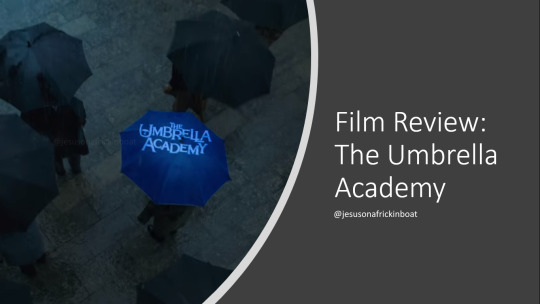


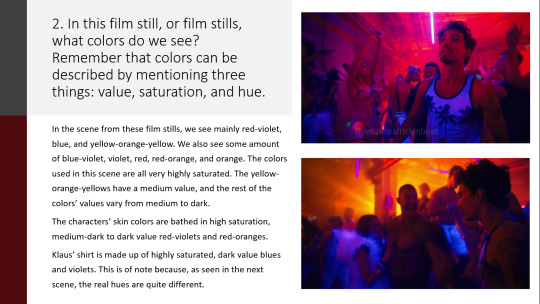


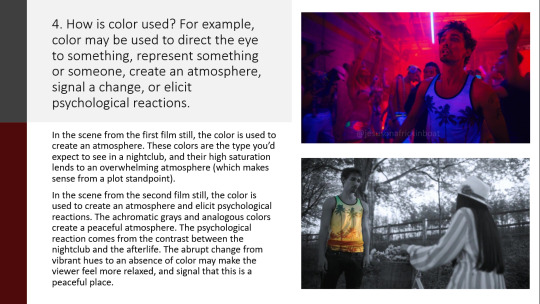


Film Review: The Umbrella Academy
Season 1, Episode 7 “The Day That Was”
One of my projects in Color Theory this semester was called Film Review. The assignment was to pick one or more stills from a movie or TV show and answer five questions about how color was used during the scene(s). I chose the Klaus-centric rave & afterlife scenes from s1 ep7. Honestly, I probably wrote a lot more than actually necessary for the assignment 😂 The black & white except-for-Klaus’-shirt afterlife scene was actually the first thing I thought of when the teacher gave us the assignment, mostly because I’ve been trying to figure it out for 3 years now. Obviously with the new revelation about color in the afterlife, I finally have what I’d call an answer (though I guess could still be labeled as a theory). But! I did this assignment back in April, so these are my observations/theories from then.
Image ID below the read more (due to length)
[Image ID: nine powerpoint slides.
Slide 1: an image of a season 1 title card that is a birds eye of people dressed in black holding black umbrellas, with one holding a blue umbrella that says “The Umbrella Academy” standing in the rain. The slide says “Film Review: The Umbrella Academy. @jesusonafrickinboat”
Slide 2: a season 1 promo image of Viktor, Five, Allison, Luther, Diego, and Klaus. The slide title reads, “1. What film did you chose? When was it made? Who is the director or directors?” The body text reads, “The Umbrella Academy (2019-present) Showrunner: Steve Blackman
The Umbrella Academy is a show about a dysfunctional family with superpowers trying to prevent the apocalypse.
Sir Reginald Hargreeves adopted seven children at birth from around the world, each with a different power, and gave them numbers for names (Number One through Seven). He trained the kids to be superheroes from a young age. When they were 13 years old, he started sending them on missions to defeat villains as The Umbrella Academy.
The siblings all have trauma surrounding their childhoods, mostly stemming from their training and missions.”
Slide 3: a season 1 screenshot of 13 year old Luther, Diego, Allison, Klaus, Five, and Ben lined up in their uniforms after the bank heist. The slide title reads, “1. What film did you chose? When was it made? Who is the director or directors? (cont.)” The body text reads, “I specifically chose film stills from Season 1 Episode 7 ‘The Day That Was’ (2019) Episode director: Stephen Surjik
The film stills I chose are from sequential scenes that follow of the siblings, Klaus (Number Four), whose powers have to do with the dead. At this point in the show, he is getting sober after a life of drugs (which dampen his powers).
In short: Klaus goes to a nightclub to find one of his brothers and dies after being thrown to the ground, hitting his head on the concrete floor. He goes to the afterlife where he meets God (who doesn’t like him) and talks with his adoptive father. Klaus then comes back to life.”
Slide 4: two season 1 screenshots from the rave scene. The first shows Klaus with Ben behind him and people dancing around them. The second shows Klaus, Luther, and the girl Luther brings home from the rave with people dancing around them. The slide title reads, “2. In this film still, or film stills, what colors do we see? Remember that colors can be described by mentioning three things: value, saturation, and hue.” The body text reads, “In the scene from these film stills, we see mainly red-violet, blue, and yellow-orange-yellow. We also see some amount of blue-violet, violet, red, red-orange, and orange. The colors used in this scene are all very highly saturated. The yellow-orange-yellows have a medium value, and the rest of the colors’ values vary from medium to dark.
The characters’ skin colors are bathed in high saturation, medium dark to dark value red-violets and red-oranges.
Klaus’ shirt is made up of highly saturated, dark value blues and violets. This is of note because, as seen in the next scene, the real hues are quite different.”
Slide 5: two season 1 screenshots from the afterlife scene. The first shows Klaus and God, a little girl on a bike, Klaus’ shirt is the only thing that still has color. The second shows Klaus looking up at Reginald in the barbershop scene, there is no color in the entire scene. The slide title reads, “2. In this film still, or film stills, what colors do we see? Remember that colors can be described by mentioning three things: value, saturation, and hue.” The body text reads, “In the scene from the first film still, we see mostly grays that vary in value from light to dark. There are three colors present: orange, yellow, and green-blue. All three colors are highly saturated. The orange values vary from dark to medium-light. The yellow values vary from medium to very light. The green-blue values vary from dark to light.
In the second half of the afterlife scene, Klaus’ shirt is covered by a black cape, removing all color from the scene. From that point until the end of the scene, there are only achromatic grays with a range of values from dark to light.”
Slide 6: two season 1 screenshots, one from the rave scene, one from the afterlife scene. The first shows Klaus with Ben behind him and people dancing around them. The second shows Klaus and God, a little girl on a bike, Klaus’ shirt is the only thing that still has color. The slide title reads, “3. What kind of palette do we see? Did the filmmaker use a known color scheme, such as monochromatic, analogous, complementary, triadic, tetradic, or split complement? Is there a noted absence of hue? Or has the filmmaker thrown in almost every hue in the rainbow?” The body text reads, “In the scene from the first still, the filmmaker didn’t use a known color scheme. We would call it a ‘Half Wheel’ palette.
In the scene from the second film still, there is a noted absence of hue except for Klaus’ shirt, which uses an analogous palette.”
Slide 7: two season 1 screenshots, one from the rave scene, one from the afterlife scene. The first shows Klaus with Ben behind him and people dancing around them. The second shows Klaus and God, a little girl on a bike, Klaus’ shirt is the only thing that still has color. The slide title reads, “4. How is color used? For example, color may be used to direct the eye to something, represent something or someone, create an atmosphere, signal a change, or elicit psychological reactions.” The body text reads, “In the scene from the first film still, the color is used to create an atmosphere. These colors are the type you’d expect to see in a nightclub, and their high saturation lends to an overwhelming atmosphere (which makes sense from a plot standpoint).
In the scene from the second film still, the color is used to create an atmosphere and elicit psychological reactions. The achromatic grays and analogous colors create a peaceful atmosphere. The psychological reaction comes from the contrast between the nightclub and the afterlife. The abrupt change from vibrant hues to an absence of color may make the viewer feel more relaxed, and signal that this is a peaceful place.“
Slide 8: two season 1 screenshots from the afterlife scene, taken seconds apart. The first shows Klaus sitting on a chair in the barbershop, looking upwards, his shirt is the only thing with color. The second shows Klaus sitting on a chair in the barbershop, his gaze moved downwards, covered by a black hairdresser’s cape, with Reginald partially seen in the background. The slide title reads, “4. How is color used?” The body text reads, “While these stills are from the same scene as the previous afterlife stills, this particular use of color ties into the characters and plot. The afterlife color scheme remains the same until the first still. However, from the second still until Klaus is revived, the absence of color envelops the entire frame.
The first thing Reginald does when he enters the scene is cover Klaus’ shirt, effectively removing the color from the scene. I believe this represents Klaus’ relationship with his adoptive father. In the show, Reginald is an antagonistic figure to Klaus and his siblings – they weren’t allowed to just be children, and he never allowed freedom or individuality. By covering Klaus’ shirt, Reginald removes Klaus’ individuality and takes control of the scene.
After removing the color, the atmosphere of the scene goes from peaceful to sorrowful (this is also reflected in Klaus’ change of facial expressions between film stills).”
Slide 9: two season 1 screenshots, one from the rave scene, one from the afterlife scene. The first shows Klaus with Ben behind him and people dancing around them. The second shows Klaus and God, a little girl on a bike, Klaus’ shirt is the only thing that still has color. The slide title reads, “5. How does color work with the other elements of the film? For example, do the colors seem to work in harmony with the sound and action? Or do color choices seem intentionally incongruous?” The body text reads, “In the scene from the first still, the colors work in harmony with the sound and action. People move chaotically around the club to very loud electronic dance music, which works together with the high saturation colors. As Klaus, an addict in the midst of getting sober, walks through the nightclub filled with dancing and drugs, the atmosphere is overwhelming. The colors, sound, and action are working in harmony against Klaus, whose actions are incongruous with the other elements.
Throughout the scene in the afterlife, an accordion song plays. It gives the afterlife a peaceful, old-timey feel. Compared to the nightclub, Klaus is more relaxed and at peace during the first half of the afterlife scene. The colors work in harmony with the sounds and actions.” /End ID]
#tua#The Umbrella Academy#klaus hargreeves#tua spoilers#tua s1#tua s1 spoilers#tua s3#tua s3 spoilers#<-- just to be safe#reginald hargreeves#tua theory#tua analysis#color analysis#film analysis#I really hope I did the image IDs okay let me know if I missed anything#long post
48 notes
·
View notes
Note
Everything Everyone else hasn't asked yet ᕕ( ᐛ )ᕗ
ᕕ( ᐕ )ᕗ
[Weirdly Specific Artist Ask Game]
3. What ideas come from when you were little
rather than saying any specific ideas came from when i was a kid, i think,... there are tropes that i still love and draw on and can credit to some of the things i read and watched as a kid. one big example is hidden identities - my most trope ever - all has a big basis on some of my earliest Media Memories, like detective conan, danny phantom, ouran high school host club, alex rider, and so on ahsdg
6. Anything that might inspire you subconsciously (i.e. this horse wasn't supposed to look like the Last Unicorn but I see it)
i do not know my own subconscious mind well enough to say 💀
8. What's an old project idea that you've lost interest in
i had a really big mob pscyho fic i wrote 30k on in 2019... don't know if i'll ever circle back to write the rest. there's been countless comic projects that i started and dropped over the years as well...
as for illustrations i have a number of half-started DP illustrations that may or may not ever be finished 🤷♂️
9. What are your file name conventions
either things languish in the land of Untitled Document, or they get ... passable attempts at descriptive names like "project title ch2 v1 inks"
10. Favorite piece of clothing to draw
i always like drawing shirts! clothing folds in general are a big area i'd love to sink some more practice into, tho
11. Do you listen to anything while drawing? If so, what
Oh Always. i rotate between music (shuffling my spotify likes or going start-to-end on an album), podcasts (dungeons & daddies or dimension 20 mostly), youtube (IE, gamegrumps, izzzyzzz) and/or reality shows my friends put on :>
12. Easiest part of body to draw
faces/heads? i feel like i put most of my practice there because i love to draw expressions. hands might be what i practice second most
13. A creator who you admire but whose work isn't your thing
another one i say, i dunno. if i follow artists on social media that i admire, i'd count their work as "my thing" even if it's outside the range of what i might create myself 🤔
15. *Where* do you draw (don't drop your ip address this just means do you doodle at a park or smth)
at my desk, on the couch, or in bed mostly! i've been trying to get myself out to draw at the park more
17. Do you eat/drink when drawing? if so, what
i have a really bad habit of eating 10,0000 LifeSaver mints while i draw if i am not being careful 💀
18. An estimate of how much art supplies you've broken
sooooooo many pencils. 20+? in highschool and most of uni i was really picky about using fancy HB, 2H and 4H pencils for all my sketchbook work but at a certain point i started preferring mechanical pencils
20. Something everyone else finds hard to draw but you enjoy
i don't know about Everyone, but comics/sequential art, maybe? pacing can be quite difficult but it's a challenge i really enjoy conveying on the page.
21. Art styles nothing like your own but you like anyways
anything creepy crawly horror EHehehehe also anything papercraft, multi-media-y.... or like, super solid pen-and-ink. fine lines, black and white, that sort of thing
22. What physical exercises do you do before drawing, if any
if i remember i try to stretch my wrists 💀
23. Do you use different layer modes
ye!! whatever's needed at the time. i'm fond of multiply layers with purple ink for shading.
24. Do your references include stock images
oh, yep, stock images are actually one of my favorite sources for references outside of pose-specific reference resources like line-of-action, adorkaStock, etc. but stock photos (specifically sites like Pexels) are great for locations, perspective, animals, inanimate objects, or if i don't know exactly what i'm looking for
26. What's a piece that got a wildly different interpretation from what you intended
i'm not sure this has happened to me to that degree? like there's definitely been minor differences in interpretations when it comes to my comics (dialogue doesn't always land or imply what i intended) but i don't think i've ever had something taken wildly differently
27. Do you warm up before getting to the good stuff? If so, what is it you draw to warm up with
i don't normally, but if i do, it's usually standard sketchbook randomness - heads, hands, shapes, squiggles, objects around the room. the cats...
28. Any art events you have participated in the past (like zines)
i've contributed to a number of zines and things over the years :>
Welcome to Hell - 2014 & 2015
Sakana - Catch of the Day 2017 (I don't think I ever posted the full piece online, actually...?)
one for Danny Phantom coming up in December 👀
i also wrote for the WtH big bang in 2018, beta'd for the Fullmetal Alchemist Big Bang in 2021, and this year illustrated for the Danny Phantom Invisobang!
there will probably be more in the future. Love Me A Project
29. Media you love, but doesn't inspire you artistically
maybe podcasts? i've definitely drawn for podcasts before (gorgug from d20, some TAZ stuff way back in the day...) but i'd say it's rare and that the lack of a visual component separates it from media that inspires me artistically, or at least, does so directly
8 notes
·
View notes
Text
[Theory & Concept Analysis] Revenge on the Real One: The Heir and The Spare

Source: https://tapas.io/series/revenge-on-the-real-one/info
By: Peggy Sue Wood | @pswediting
The concept of the “heir and the spare” traditionally refers to the practice of having two potential successors in a royal or aristocratic family, usually brothers. The “heir” is the eldest and the one who is expected to inherit the title, lands, and other assets of the family. The “spare” is the second born and is seen as a “backup child” in case something happens to the heir, such as their death or inability to fulfill their duties due to injury or illness.
This did not mean that the spare was meant to be a literal replacement, although I have seen some literary depictions that perpetuate that idea. Rather, the “spare” was more like a secondary heir who received similar education and training, often expected to be an aid to their older sibling and take on various tasks should the official heir inherit the position as planned. Of course, as time went on, the meaning of these roles changed, and the higher up the nobility or royal rank, the more likely the secondary heir was to become a rival instead of an aid–sometimes leading to callous deaths at the hands of one’s own family.
The tradition of having an heir and a spare dates back to medieval times when the risks of childbirth and early death were much higher. It was believed that having two potential heirs would ensure the continuity of the family’s lineage and wealth. The concept was particularly important for royal families who were expected to produce a male heir to ensure the stability of the monarchy. Today, the concept of the heir and the spare is still used in some royal families, such as the British monarchy. However, the practice has become less common in modern times as the risks associated with childbirth have decreased, and families no longer need to rely on multiple heirs to secure their lineage and wealth. I have seen this concept played out in a number of different anime, manga, and various other forms of the sequential art media, but one example that I’d like to point today is the series Revenge on The Real One, which currently available on Tapas.
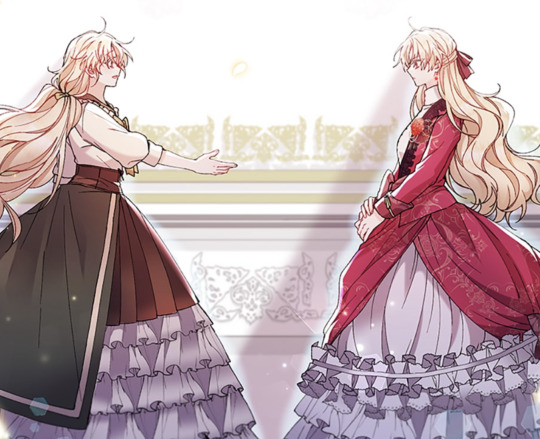
Source: Revenge on The Real One, Chapter 2
Now, it’s not very clear whether Helga and Hillianne are twins or actually switched at birth. The “they are twins” trope is a more common approach when siblings look as alike as these two daughters do, but given that both mothers claim to have had a single child, I’m going to guess that the two daughters are not twins despite looking extremely alike.
In appearance, Helga and Hillianne are practically identical, with a few minor differences in appearance. Helga has sharper eyes, and Hillianne has slightly straighter hair. They have the same blonde hair and red eyes as their father, with similar heights and builds. Personality-wise, though, the two could not be more different, with Hillianne being open and bright while Helga comes off as cold and standoffish.
Hillianne, raised as a commoner, is not as adept at the high-society social skills that Helga has gained over the years. Hillianne is also not nearly as innately talented in education-related areas, unlike Helga, who has a firm grasp on politics, business, and the arts with her superior intellectual prowess for such materials. To put it bluntly, Hillianne is more bronze than brains, while Helga is more brains than bronze.
Their personalities are definitely a result of nurture (how they were raised), but their differing aptitudes seem to be more so related to their natures (who they come from)–at least, that is what the Duchess believes.
Helga has magical capabilities that Hillianne doesn’t seem to possess, while Hillianne seems to possess a better aptitude for swordplay. This supposedly ties into their lineage, with Duke Yutrit and his family being one of the few lines that still produce magical offspring, explaining Helga’s aptitude for magic. Meanwhile, Duchess Yutrit, the supposed stepmother of Helga, is revealed to have strong sword skills, which would explain Hillianne’s aptitude for swordplay. If the maid truly switched the two children, then their differences in appearance and aptitudes can be explained by their lineage. As daughters of the Duke, both Helga and Hillianne would have had a chance of inheriting magic. However, swordplay would have been a inherent skill unique to the daughter of the Duchess–or so the Duchess and Helga might believe.
In reality though, while physical traits and innate talent can give some individuals an advantage in activities like swordplay, it is still a skill that can be earned through practice and training. As such, who is to say that Helga would not be capable with a sword if given better circumstances wherein the Duchess was not abusing her or that Hillianne would not be capable of magic if taught how to use it?

Source: Revenge on The Real One, Chapter 2
Despite Helga’s personal accomplishments and progress, she has not been given the same opportunities or assurances as Hillianne upon her return to the Yugrit house. By this, I mean that Helga has been relegated to the role of a spare who is “acting heir” until the real heir is returned.
In this world, women can inherit their father’s title. So, as the “sole” daughter, Helga would have been an heir to the duchy had Hillianne not returned. As the heir apparent, why was Helga, therefore, engaged to a prince?
From this question stems my theory that the Duke faked the idea of the daughters being switched for his own benefit, at the cost of his wife’s sanity and his daughters’ wellbeing.
We know that the Duchess cannot have more children (if she could, she certainly would have done so already). With that said though, the Duke obviously can have more children and has a reason to do so. In addition to creating a spare heir, the Duke’s house–which is a magical household prioritized by other magic-focused families like that of the royal family–is in a prime position to have a child be chosen for the fiance role of the prince, legitimate or not. He cannot give up an heir if he plans to have the family line continue, but he could give up a spare and, as it so happens, the maid he has been sleeping around with gave birth to another daughter that looks just like the one he and his wife have.
It is possible that the Duke knew the Duchess would hate his illegitimate child and possibly even try to kill it to prevent any challenges to the first daughter’s claim to the Duchy. The Duchess could not care less about the agreement with the royal family beyond keeping the reputation of the house she’s married into, so it is a pretty good bet that had the Duke not promised a child to the royal family the maid’s daughter would have been eliminated or tossed out.
It is very likely that the Duke planned to have Hillianne return at some point to be either an heir or spare who would marry the prince. When the Duchess learned of the spare, the Duke may have told her of the switch to prevent the secondary child from being killed or targeted by the Duchess. This is just a theory, but it raises some interesting questions about the motives and actions of the Duke and the maid.
We know that the maid told Hillianne that she was the true daughter of the Duke, so it is possible that the two were really switched before the maid left. However, I think that rather than being switched, the Duke and maid probably agreed to tell Hillianne she was the true daughter to maintain the lie told to the Duchess. Maybe the Duke whispered words of love to the maid, or maybe it was promised that agreeing to the lie would serve Hillianne well in the future because she could someday enter the house as a “legitimate” child–regardless, I do not think that Helga and Hillianne were ever actually switched.
What makes me think this includes a few factors. The first is the suspicious carelessness and callous choices of the Duke, which show that he only cares about having his two daughters serving roles that support and benefit the house’s continued linages. However, the second relates to how Helga and Hillianne have developed physically.
Although Helga and Hillianne looked even more alike in their youth than they do now, as they’ve aged, they have developed different eye shapes. There may also be some other smaller physical qualities setting them apart as most people close to Helga can immediately tell the difference between her and her sister. Hillianne has a round eye shape similar to what little we have seen of the maid but which neither the Duke nor the Duchess have. Mean while Helga had round eyes in her youth, as many children in these types of stories do, but as she has aged, she has developed the same sharp eye shape as the Duke and Duchess.
I believe that the Duchess believes Helga is not really her daughter, but I think that this is misconception brought on by the Duke, the maid, and other Yutrit staff to protect the other daughter of Yutrit house. At least, that is my theory. What do you all think? Let me know!
#Revenge on the Real One#The Real Daughter Has Returned#The Real Daughter Is Back#manhwa#analysis#concept analysis#theory
5 notes
·
View notes
Photo

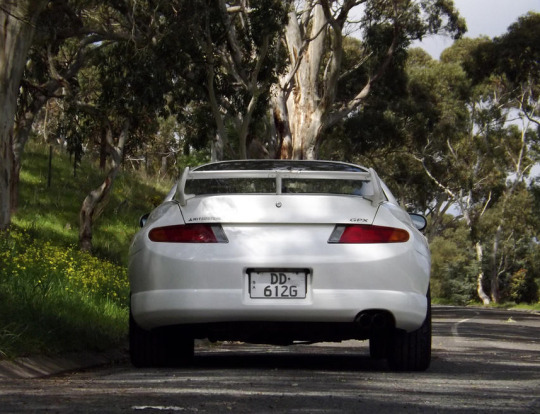





Mitsubihi FTO GPX
The lines of the Mitsubishi FTO perfectly reflect that we are dealing with a light model (less than 1,200 kg in the worst case) and are also reminiscent of those of other contemporary sports cars, including those of other manufacturers, such as Toyota. At its launch, it was offered with two gasoline engines, a 1.8 four-cylinder and a 2.0-liter V6, mechanics that could be combined with the manual gearbox that was equipped as standard or an automatic transmission with the possibility of sequential actuation, called INVECS II . The V6 mechanics, in addition, was offered with two specifications, including a more powerful one, called MIVEC, which instead of producing the 168 CV that the basic model delivered, produced 200 CV at 7,500 revolutions per minute. This last mechanic was available in the Mitsubishi FTO GPX, a special version that was launched to commemorate that the model had managed to win the title of "Car of the Year" in Japan. Among the characteristics of these FTO GPX was the incorporation of a differential limited slip that was responsible for ensuring maximum traction capacity, in addition to having specific elements both outside and inside. A total of 207 copies of this edition were manufactured between 1994 and 1995. Originally, the FTO was a model destined exclusively for the Japanese market, however, after verifying that a large number of units were being imported to other countries, such as Australia, New Zealand or the United Kingdom, it ended up being officially marketed in these three nations.
21 notes
·
View notes
Note
6, 7, 12, and 15 for the ao3 wrapped!! sorry if you've already answered these I'm bad at keeping track of which numbers you've done gahfjsjdkdkak😅
MWAH benny <333 its okay i can never remember which ones ive answered before either sfkjfnvbsfbjn
6. Favorite title you used
ohhh this is hard <3 ill give a top 3:
windows down, scream along (slasherverse #3)
Steve Harrington: a thesis on wanting, and being wanted
holding your face in my hands like the world beneath my fingertips (sesdinikhil)
[honorable mention, the working title in my gdocs for it's friday i'm in love: fabian has three sequential breakdowns about getting his kisses in (or not)]
7. If you use song lyrics, which artist’s songs did you pull from the most?
i used song lyric titles CONSTANTLY lmao, but over all the all the titles i've used over the years, the clear stand out artist is mitski <3
12. How many WIP’s do you have in your docs for next year?
too many to count 😵💫
currently i have fifteen unfinished d20 works on my spreadsheet from this year- but that isn't counting non d20 wips (of which there are many) and d20 wips i have in my drive that i haven't worked on this year (of which there are also many) kkjsfvnksjfb
15. What WIP are you taking into next year with you?
all of them? all of them <3 who knows what i will or wont start or finish next year but they're all coming along for the journey with me <3
send me ao3 wrapped asks from this list!!
3 notes
·
View notes
Text
Novel Writing in Word Doc
One thing I can say about writing a huge novel in a word doc is DON'T.
It's my opinion that making one gigantic, super-sized word doc is a BAD idea. It's tempting, I know, but it's a fact that the more you stick in there the more likely it can become accidently corrupted. (For anyone curious, here is a nice article on what causes word doc corruption: What Causes Microsoft Word Document Corruption? - Dataloss.com )
It's also difficult to navigate a huge document all the time or copy and paste one chapter into another etc. I had started using the navigation window with specific headings, but I find it's really not a good idea once the document gets beyond 80 pages.
I decided to break the chapters into their own word doc files and I numbered them like this: TitleChptr-001. Using the extra zeros help the numbers sit sequentially rather than having "1" followed by "10". It also allows me to do revisions, which I can then save as TitleChptr-001-1, or TitleChptr-001-2, etc. I can also easily change a chapter number just by changing a file name and the doc's title.
When I finally reach that "final draft" THEN I'm going to put them all into a gigantic file for the purposes of printing and/or sending.
This is how I'm rolling these days, but if I find a better way, I'll be sure to share it. I know this is more nuts & bolts than talking craft, but sometimes we need to talk nuts & bolts.
1 note
·
View note
Text
Nathan Salsburg — Landwerk No. 3 (No Quarter)

Landwerk No. 3 by Nathan Salsburg
For the third volume of his Landwerk series, guitarist and archivist Nathan Salsburg again isolates fragments of archival recordings to form loops over which he layers minimalist electric guitar and, less prominently, resonator guitar, piano, and/or organ. The staticky groan of an organ or bleat of a clarinet along with the static itself thus serve as half of a conversation across more than a century of sound technology. The effect is akin to drone, with the spare, skeletal guitar lines usually acknowledging the repetition of the loops without themselves necessarily repeating.
As on the first two volumes of the series, the tracks run around ten minutes each and are titled only with sequential Roman numerals that reflect the continuity of the (so far, at least) three-part work, these being numbered X-XIV. Sometimes, as on “X,” the guitar melody takes a cue from the sample, in this case, joining it in a festive march. On other tracks, such as “XII,” the whirling of the 78 disc perhaps suggests a rhythm.
Comparison with the original recordings is revealing. Thus, on “XI,” a repeated cluster of seven lilting notes from the piano playing of Sylvia Schwartz, accompanying her father Abe’s klezmer fiddling on a 1920 recording, and the static in which they are embedded provide a matrix for hesitant clusters of reverby guitar notes into which single, elongated fiddle tones occasionally intrude. The result, like the traditional tune, feels neither quite minor nor major; the pace is glacial, but the ten minutes nevertheless pass swiftly in the trance-like state that the track induces.
There are numerous little details that give the compositions a sense of forward motion. Spare, isolated piano chords surface around 3:00 to share space with the guitar on “XI,” for instance, while on “XIV” an organ takes over for the guitar from around 4:00 to 6:00 before retreating into the background. On “XIII,” driven by a sample from a klezmer orchestra, the guitar begins with chords, shifts to single-note runs, picks up the tempo briefly in the closing minutes, and returns to the chords at the end.
The use of sonic artifacts in guitar music is shared with, for instance, Daniel Bachman (as I observed in a recent review of his Almanac Behind for Dusted) and traces back at least to John Fahey’s fourth album. In Salsburg’s case, the noise plays more of an elemental than a narrative role, creating along with the loops the architecture of the sound. Landwerk No. 3 is, like its predecessors, a work of craggy beauty that does homage to a world—that of pre-war European Jews—destroyed in the same wave of technology and social change that made possible the preservation of its traces in the archival recordings and, in turn, rendered the recordings obsolete. It is easy to imagine that Sylvia and Abe Schwartz, if somehow able to hear “XI,” would marvel and approve.
Jim Marks
#nathan salsburg#landwerk no. 3#no quarter#jim marks#albumreview#dusted magazine#guitar#archival recordings
6 notes
·
View notes
Text
Swooning over these marbled covers and page edges. Undated, circa turn of the century, complete two volume edition published by Hovendon Company, New York. John Hovendon bought International Book Co. during the 1890s and renamed it Hovendon Company. The page numbering in Volume I is in error. Pages are in sequential order through Chapter VIII, Page 366. The next page, which begins Chapter IX, starts at Page 15. Content does not appear to be affected. Volume II is 376 pp. Quarter calf over marbled boards. All edges marbled with marbled endpapers. Backstrips are detached on right-hand side and need to be glued. Piece of leather missing from top of backstrip on Volume I. Slight wear around edges. Marginalia on title page of both volumes. Light tanning. Pages are otherwise crisp and clean.
The History of Tom Jones, a Foundling, often known simply as Tom Jones, is a comic novel by English playwright and novelist Henry Fielding. It is a Bildungsroman and a picaresque novel. It was first published on February 28, 1749 in London and is among the earliest English works to be classified as a novel.[1] It is the earliest novel mentioned by W. Somerset Maugham in his 1948 book, "Great Novelists and Their Novels" among the ten best novels of the world. The novel is highly organized despite its length. Samuel Taylor Coleridge argued that it has one of the "three most perfect plots ever planned", alongside Oedipus Tyrannus and The Alchemist. It became a best seller with four editions published in its first year alone. It is generally regarded as Fielding's greatest book and as an influential English novel
instagram
#books#books & libraries#booksbooksbooks#bookshelf#bookshop#bookstore#home library#old books#antique books#antiques#dark academic aesthetic#dark academia#rare books#bookblr#bookish#Instagram
6 notes
·
View notes
Text
it will be 20 years until i get my oc troopers bios up but here’s the lowdown <3
st - 1136 : skipper / kip
scuba trooper in kit fisto’s legion of clones. serves specifically as a scuba trooper and aquatics expert. absolutely adores sea life and is fascinated by water. during his cadet days, he often got caught for wanting to see if he could swim in the waters. that eventually took him towards his current career path. his name came from what people would often call the head of a underwater expedition; skipper was at first used mockingly in his cadet days and eventually became truth. sometimes people shorten it to kip or skip. he’s proud of who he is. outside the water, kip is a very easy going trooper who thrives off of making people laugh in the darkest times, almost as a light in the dark. he’s usually referred to as the annoying little brother no one expected but always got. his jokes and humor are never at the expense of anyone— aways about himself or anything he can think of! this goes on even when he loses his arm and is on the operating table— he asks his medic “could you give me a hand?”
ct - 5678 / sequence
his name sounds pretty simple, right? something in reference to how his serial number is in sequential order. but that’s not all there is to him. growing up on kamino, they are made to serve specific purposes. he didn’t much care for those purposes— only every cared when it pertained to his batchmates wellbeing. sequence is fascinated by the science behind cloning a specific dna sequence to their own liking. that is where he gets his name. he may be the clone that is most well versed in their dna, with dedicated studies mocked up in barracks. he’s not so much introverted, hes more of a person who only speaks if they have anything to say or provide. he is softspoken and kind, always there to help provide a quiet companionship. if you need a better understanding of the mission on a chemical level? he’s your guy! currently, he’s unassigned in terms of who he works with (jedi etc). so it could be up to plot!
ct - 2222 / twos
twos is the boisterous, heart in the right place, himbo of all my troopers. his name comes from not only referencing his serial number, but also the fact that everyone thinks he has a grand total of two braincells. he is often the main muscle people put into their plans, because he will follow the order and adapt to it as much as needed. he is a bit of a loud idiot sometimes, but he is unafraid of letting people know he doesn’t know what’s going on or what’s happening. twos would asked it explained to him so that he can fully understand the assignment, questions included. mostly? twos is constantly, unashamedly himself. he is also unassigned, so that could he up for plots!
ct - 1013 / brightly
brightly is the quietest among the group. he got his name since being a young cadet afraid of the dark. his brothers made fun of him often. and on a training expedition gone wrong, stuck in the darkness of a moon, brightly came with an idea. he rigged a bomb and threw it to go off as vibrantly and in the most distracting way possible to get everyone to safety. there, he was awarded for his quick thinking. but he doesn’t think he deserves it. he was just afraid of the dark… and he wanted light to shine brightly to make it go away. now he is esteemed with the title explosives expert. he is also unassigned!!
5 notes
·
View notes
Text
MIASMA MYOPIA 1

Floyd Tangeman, editor of assorted small press anthologies — Tinfoil, Jaywalk, Cowlick, and another title he’s looking for a publisher for — dropped his first comic of solo authorship, having worked on it for a year and a half. I’m familiar with his work from his presence in those anthologies, but most of those anthologies favor a certain opacity in their accreditation, in that a table of contents page will list contributors in the order their work appears but without page numbers or anything, so you just page through looking for stylistic shifts, and many of the artist work such shifts into their approach to pages. Miasma Myopia might not make Tangeman’s work more identifiable, seen in the pages of Tinfoil, but it does further elucidate his approach, in terms of how his work as an editor is about the community he’s a part of, and the reciprocal nature of what it means to be a part of a community: Not only is it easy to imagine the pages of this comic running in Tinfoil, it’s also easy to imagine misreading different pages as the works of different people. The center spread, that a staple binding is inclined to open to, shows a totally different style than the rest of the book.
My favorite pages here tread a line between a scribbly energy and a larger composition, presenting a cartoon world.that feels coherent despite being made out of wild marks. This is arguably the baseline style, or where Tangeman seems most adept, though you also only see it on a few pages. Overall, exploration is favored over sticking to a sure-footed approach. Pages featuring a ton of tiny panels laid out in a grid come off more like a spur of a moment decision of what would be a cool thing to do rather than a measured response to the question of what the story needs to be told. When we see figures with faces, I’m not convinced Tangeman is interested in that kind of cartooning, one that includes an approach to characterization. One of the things people like about Tinfoil is how its cartoonists seem to reject the established alt/literary comics canon in favor of an approach that puts images on a page with text and some idea of sequence and calls it a comic. That’s not to say that Tangeman doesn’t know comics history, or doesn’t love Justin Green, (he does) but he’s trying to operate from a position of freeform exploration rather than closely observed rigor, and to be a person, particularly a person under observation, does not feel particularly free, and so capturing a “well-observed character” would be anathema to the artistic mission. Tinfoil and Cowlick are anthologies absent a sharp or incisive eye. Evocation is favored, or inner questing, but there isn’t the sense you get from vintage underground cartoonists that the author feels like a psychedelic voyages have given them insight into other people and how full of shit they are. They nonetheless delight in the inner voyage, where what is “learned” is ungrounded in reality, but still feels profound. The question of “does this mean anything” is answered with a shrug. This isn’t a bad approach, but how much sympathy you have for it likely depends on how uptight you are. (Imagine a digression here where I pointed out how Uptight was the name of Jordan Crane’s single-artist anthology title for Fantagraphics, and I posited that approach as the opposite of what Tangeman’s up to.) There is a sequence here of single-page images I took as nonnarrative, sketchbook ruminations on a theme. Your enjoyment of Miasma Myopia will likely vary on how willing you are to look at such things and interpret them as sequential art.
5 notes
·
View notes